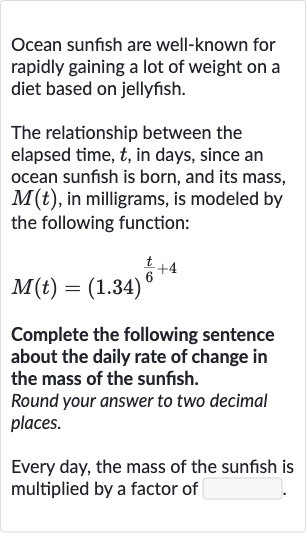AI tutor
Welcome to Bytelearn!
Let’s check out your problem:

Ocean sunfish are well-known for rapidly gaining a lot of weight on a diet based on jellyfish.The relationship between the elapsed time, , in days, since an ocean sunfish is born, and its mass, , in milligrams, is modeled by the following function:Complete the following sentence about the daily rate of change in the mass of the sunfish.Round your answer to two decimal places.Every day, the mass of the sunfish is multiplied by a factor of
Full solution
Q. Ocean sunfish are well-known for rapidly gaining a lot of weight on a diet based on jellyfish.The relationship between the elapsed time, , in days, since an ocean sunfish is born, and its mass, , in milligrams, is modeled by the following function:Complete the following sentence about the daily rate of change in the mass of the sunfish.Round your answer to two decimal places.Every day, the mass of the sunfish is multiplied by a factor of
- Identify Function: Identify the function that models the mass of the sunfish.The function given is . This function represents the mass of the sunfish as a function of time in days.
- Determine Rate of Change: Determine the daily rate of change.The daily rate of change is the factor by which the mass changes when increases by day. To find this, we need to calculate and divide it by .
- Calculate : Calculate .
- Simplify : Simplify .
- Calculate Rate of Change: Calculate the daily rate of change.The daily rate of change is
- Simplify Expression: Simplify the expression for the daily rate of change.The terms cancel out, leaving us with .
- Calculate Value: Calculate the value of . Using a calculator, we find that .
- Round Rate of Change: Round the daily rate of change to two decimal places.The daily rate of change, rounded to two decimal places, is approximately .
More problems from Interpret parts of quadratic expressions: word problems
QuestionGet tutor help
QuestionGet tutor help
QuestionGet tutor help
QuestionGet tutor help
QuestionGet tutor help
QuestionGet tutor help
QuestionGet tutor help
QuestionGet tutor help
